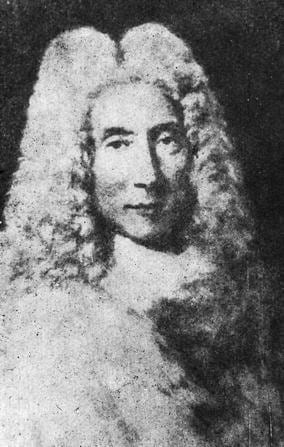Fadlurrahman Manaf
Surabaya, Indonesia

Homini Verminoso (worm man) was the nickname given to the Paris professor Nicolas Andry de Bois-Regard, so called because of his work in parasitology.1,2 In 1700 he wrote a book titled De la generation des vers dans le corps de l’homme. De la nature et des especes de cette maladie, les moyens de s’en preserver et de la guerir, translated as “The generation of worms in the human body. The different kinds and types of this disease and the ways of preventing and curing it.”1-3 Because of this work he has also been called the “Father of Parasitology.”2
Born in Lyon in 1658, he became a priest and for some time studied theology.1-4 Then in 1690 he went to medical school in Rheims, graduating in 1694.1 In 1724 he became Dean of Faculty of Rheims and also a critic for the Journal des Savants.1,5 During this time he was opposed by many of his colleagues, especially the surgeons.2,4 He managed to have five new findings in the field of operative medicine revoked, and said that medicine was superior to surgery.1,3
In 1741, at age eighty-two, he wrote a book titled L’orthopedie ou l’art de prevenir et corriger dans les enfants les difformites du corps, translated as “Orthopaedia or the art of correcting and preventing deformities in children.” 1,3 The book consists of two volumes. The first volume describes the anatomy of the whole body, how to prevent and correct abnormalities of the body and spine, and how to the handle limb abnormalities.6,7 In the second volume he discussed abnormalities of the head and face.1
Two things are of particular interest in this book, namely the word “orthopedia” and the picture of a crooked tree. The word orthopedia, the title of this book, is taken from the Greek “orthos” meaning straight, free from deformities; and “paidios” meaning child.6,8 With this title, Nicolas intended to teach parents how to prevent and correct deformities in children. Since then the word has come to have a broader meaning, namely the art and science of preventing, investigating, diagnosing, and treating disorders and injuries of the musculoskeletal system by medical, surgical, and physical means.9 The second term, crooked tree, is intended to signify that a deformity in a young child can be corrected and allowed to grow straight.3,8,9 This crooked tree image has become the international symbol of orthopedic surgery.9
Nicolas Andry died in 1742, one year after writing the Orthopedia.1 Originally known as Homini verminoso, and opposed by many of his fellow surgeons, Nicolas Andry wrote a book at the end of his life that introduced a new terminology (orthopedia) and became a guide and inspiration for generations of orthopedic surgeons.
References
- Kohler, R. Nicolas Andry de Bois-Regard (Lyon 1658-Paris 1742): the inventor of the word “orthopaedics” and the father of parasitology. J Child Orthop. 2010; 4: 349-55.
- Ledermann, W. [The singular story of Doctor Worm -Nicholas Andry de Boisregard- and of his daughters Parasitology and Orthopaedics]. Rev Chilena Infectol. 2012; 29: 564-9.
- Kirkup, J. R. Nicolas Andry and 250 years of orthopaedy. J Bone Joint Surg Br. 1991; 73: 361-2.
- Pellegrino Ferrara, Luigi Meccariello, Cristina Ibanez Vicente, et al. Ortho- Pais, Paido. Canadian Open Orthopaedics and Traumatology Journal. 2016; 3: 35-9.
- Kirkup, J. [Nicolas Andry and orthopedics]. Hist Sci Med. 1994; 28: 205-9.
- Ponseti, Ignacio V. History of Orthopaedic Surgery. The Iowa Orthopaedic Journal. 1991; 11.
- Burrows, H. J. Leonardo da Vinci and Nicholas Andry on posture. J Bone Joint Surg Br. 1952; 34-B: 541-4.
- Swarup, I. and O’Donnell, J. F. An Overview of the History of Orthopedic Surgery. Am J Orthop (Belle Mead NJ). 2016; 45: E434-E8.
- Salter, Robert B. Basic Musculoskeletal Science and Its Application. In: Johnson EP, (ed.). Textbook of Disorders and Injuries of the Musculoskeletal System. United States of America: Williams & Wilkins, 1999, p. 1-5.
FADLURRAHMAN MANAF, MD, is a medical doctor graduated from Faculty of Medicine Airlangga University. He is interested in surgery, especially orthopaedic surgery and operative medicine.
